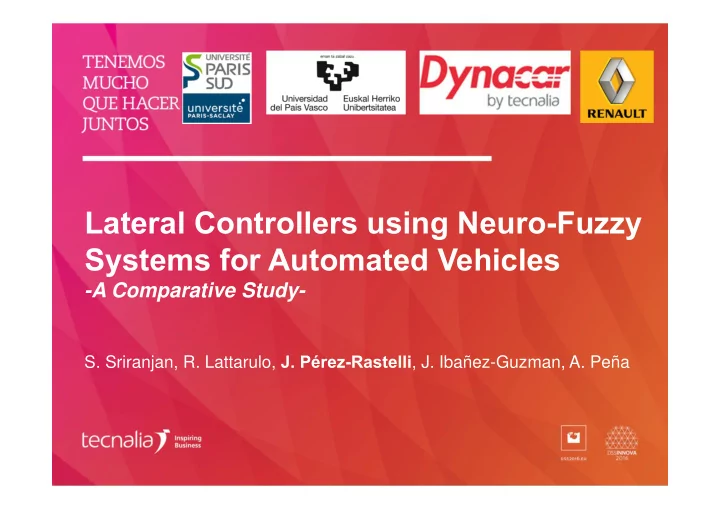

Lateral Controllers using Neuro-Fuzzy Systems for Automated Vehicles -A Comparative Study- S. Sriranjan, R. Lattarulo, J. Pérez-Rastelli , J. Ibañez-Guzman, A. Peña
Introduction In this paper, an Artificial Intelligence approach to control the steering wheel of an automated vehicle is presented. Two lateral controllers are developed: - One is based on human expertise (Fuzzy Logic). - Other is based on an Adaptive Network based Fuzzy Inference System (ANFIS) using expert driver data. Those controllers have been tested in a simulation environment, called Dynacar , and they were compared with a classical PID controller, giving good results. 2 ▌
Lateral Controllers using Neuro-Fuzzy Systems for Automated Vehicles -A Comparative Study- Simulation platforms: Dynacar • Real time simulation • High-fidelity vehicle model (multibody) • HiL, DiL and MiL • Based on C/C++, implemented on simulink block • ECUs test • Enable to incorporate proposed automated driving framework
Lateral Controllers using Neuro-Fuzzy Systems for Automated Vehicles -A Comparative Study- Control Vehicle Model Decision
Results -> Lateral control Laws 1) PID Controller [3] 2) Fuzzy Logic [1] (Based on 3) ANFIS [2] human knowledge) [1] J. Pérez, V. Milanés and E. Onieva, “Cascade Architecture for Lateral Control in Autonomous Vehicles”, in IEEE Trans. on Intelligent Transportation Systems, vol. 12, n. 1, pp. 73-82, March 2011 [2] V. Milanés, J. Villagrá, J. Pérez and C. González, “Low ‐ Speed Longitudinal Controllers for Mass ‐ Produced Cars: A Comparative Study”, in IEEE Trans. on Industrial Electronics, vol. 59, n.1, pp. 620-628, Jan. 2012. [3] R. Lattarulo and J. Pérez and M. Dendaluce, “A Complete Framework for Developing and Testing Automated Driving Controllers”, IFAC World congress 2017, Toulouse-France, July 9-14. 5 ▌
Results -> Lateral control Laws Intersections :Output of the steering positions Lane change (lateral error) 6 ▌
Conclusions: The lateral controller can be tested in a simulator environment, based on realistic models. The PID controller illustrates a good response at low speed. However, PID controller are difficult to be tuned and the gains are not adapted to the speed or the variety of circumstance of the environment. Fuzzy Logic is intuitive by thanks to using Labels and semantic rules, as humans do. Our controller are based on human drivers' experiences, giving a better result. The ANFIS techniques used to train a fuzzy controller could be considered as the best alternative. Admittedly, some results are a bit less effective than the fuzzy controller in our tests. But these performances can be improved due to they used the data gather from an expert driver to emulate the driving behaviors. In future works, this controller can be improved with a great amount of data. This lateral longitudinal control can also be improved if other variables are taking into account. Finally, a multi ‐ variable system, considering longitudinal variables, and more driving situations may improve our approach. 7 ▌
Thank you! Gracias! Eskerrik asko! Merci! Vancouver, Canada, 24 September 2017 PhD. Joshué Pérez Rastelli (joshue.perez@tecnalia.com )
Recommend
More recommend